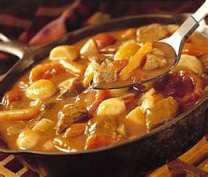This year there seems to be more rattlesnakes on the move around here. It may just be that they are being forced to move because of the drought. But it got me to think about cooking snakes. Now rattlesnake tastes to me like a cross between chicken and Cornish game hens. I like the taste.
Now rattlesnakes are not hard to prepare. You can use the same techniques for cooking other types of snakes; just the taste may be different. I don’t know of any snakes that will hurt you to eat as long as you aren’t bit.

To prepare your rattlesnake, first cut the head off about 4 inches behind head. Then hang the snake by its tail. This will let the snake bleed well. Next skin the snake. Start by splitting the snakeskin the entire length on the belly, starting from the head end.
Starting with head end, peel the skin from the meat. Then strip the entrails from body of snake and dispose of them.
At this point the snake can be eaten. But if you have time, cut the snake into smaller pieces and soak in fresh cold brine.
A word of warning: Be sure to dispose of the head immediately as they can bite for several hours. Bury the head. I recommend you do not handle the head with your bare hands.
Here is an old recipe for cooking snakes
Rattlesnake stew

Cut the snake into small pieces, roll them in flour and fry in bacon fat or lard. Season the meat with salt and pepper. Then cover the snake with water and bring to a boil. Turn down the heat and simmer for 1 1/2 hours or until tender.
While the snake is stewing, fry onions, carrots, celery and garlic in bacon fat. Then peel and dice some potatoes. Add the vegetables to the pan containing the snake and cook until the potatoes are done.
Cooking snakes is not hard; it can be as simple as roasting them over an open fire on wooden skewers. Snakes are a good source of protein and once you get over the idea of eating them are quite tasty.
Don’t be afraid of cooking snakes
Howard



Back in the 60’s with the Boy Scouts camped in the Gila Wilderness, N.M. We killed a rattler, cleaned it, and made a watery stew with wild onions and crushed mesquite beans.
If I was fixing one today I’d roll it in flour and Cajun seasoning, then fry it like chicken.
the more of em ya eat the less will be around to bite you and your dogs— eat mo snake– leave them chickens alone
do not believe this clown.snakes are in nature for a reason.they take care of the rodent problems.if you like having rats and mice around that carry very deadly dieseses go ahead.i will give a snake all the respect it deserves.i will kill if a snake only when i have to and i will not let it be wasted.so to all the fools out there who don’t like snakes,get use to them and leave them alone and they will leave you alone.a snake will try to get you only when they are threatened.that is all i going to say about the subject.
Pythons are not native to the US and have become destructive on the native species. So feel free to eat them.
i shot a bobcat in my chicken coop one night. i read that the indians liked mountain lion. charles darwin, when with the gauchos on the pampas, ate mountain lion and said it was good meat. i sautéed it in butter. it was the best ever. the other white meat. next day i took what was left to a friend who grew up in the swamps of florida eating snake, coon, gater, possum and many others. he also thought it was very good